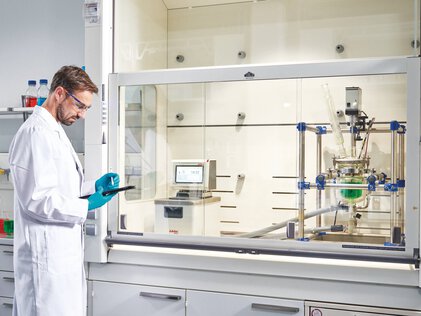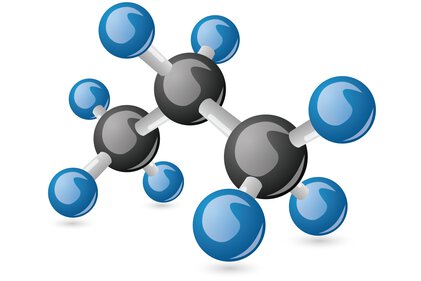Temperature control basics: Refrigerants
JULABO instruments are specialists in high-precision liquid temperature control. Our temperature control systems use a wide variety of refrigerants, depending on the intended use and application.
In principle, a distinction is made between natural refrigerants and synthetic refrigerants, each with different advantages and disadvantages.

Natural refrigerants
Natural refrigerants, as the name suggests, are found in nature as a substance. They can be produced with minimal effort and are considered environmentally friendly. Propane, propene, ethane and ethene are common representatives of this refrigerant group. They are obtained as by-products during petroleum production.
Advantages: Natural refrigerants have a low GWP value. They have no or only very little influence on the greenhouse effect. Their molecules are relatively unstable and rapidly decay in the atmosphere.
Disadvantages: Most natural refrigerants are flammable. This creates risks that must already be taken into account during product development. State regulations for the location, operation, and transport of devices with flammable refrigerants are intended to help minimize these risks.
Synthetic refrigerants
Synthetic refrigerants are produced in complex processes. Naturally occurring substances are chemically modified by the exchange of certain atoms until they have the desired properties. In the case of hydrocarbons, for example, hydrogen atoms are replaced by fluorine, chlorine, or other substances at certain points in their molecular structure. Such refrigerants are known as halogenated chlorofluorocarbons (CFCs) or hydrofluorocarbons (HFCs).
Advantages: Synthetic refrigerants can be developed for a wide range of applications. They are non-flammable and non-toxic. They are therefore also known as safety refrigerants.
Disadvantages: Synthetic refrigerants are partially responsible for depletion of the atmosphere's ozone layer and intensify the greenhouse effect. They have a high GWP value. Their molecules are relatively stable, which is why they remain in the atmosphere for a long time.
.
Global warming potential (GWP) of a refrigerant
GWP is the abbreviation for "Global Warming Potential." Its value represents a substance’s global warming or greenhouse gas potential. The GWP value of a refrigerant defines its relative global warming potential with regard to CO₂ (also known as CO₂-equivalent). The value describes the global warming effect over a period of 100 years. The higher the GWP value of a substance, the more harmful it is to the climate.
Example: The widely used refrigerant R134a has a GWP value of 1430. This means that, within the first 100 years after release, one kilogram of R134a contributes 1430 times as much to the greenhouse effect as one kilogram of CO₂. The release of 1 kg of R134a therefore corresponds to the release of 1430 kg of CO₂.
Refrigerant selection
The performance of the two refrigerant groups is roughly comparable. When selecting a refrigerant, it is therefore important to check, among other things, the ambient conditions of the operating site as well as which country-specific guidelines must be observed when operating, transporting and disposing of devices with refrigerants.
In EU countries, for example, EU Regulation 517/2014 regulates the handling of fluorinated greenhouse gases. There are also other national laws and directives that may need to be taken into account.
General information on transportation regulations
The transport regulations for appliances with synthetic and natural refrigerants vary depending on the transport route (air freight, sea freight, road) and the applicable international regulations, particularly with regard to dangerous goods regulations. The following table provides an overview of the transportation options for goods traffic.
Regulation | Air transport | Sea transport | Road transport | |
|---|---|---|---|---|
| Total filling capacity natural refrigerant <100g | UN 3358 | possible IATA special provision A103* | possible IMDG special provision 291* | possible ADR special provision 291* |
| Total filling capacity natural refrigerant >= 100g | UN 3358 | not possible | possible IMDG special provision 291* | possible ADR special provision 291* |
| Total filling capacity synthetic refrigerant <12kg | UN 2857 | possible IATA special provision A26* | possible IMDG special provision 119* | possible ADR special provision 119* |
Attention: Other regional, transport route-specific requirements may apply. For example, devices with natural coolants may not be transported through the Eurotunnel.
Summary
In summary, natural refrigerants are more environmentally friendly and cheaper to manufacture, while synthetic refrigerants are developed for specific applications and have a high global warming potential due to their chemical composition. The GWP value of a refrigerant is an important criterion in this regard.
JULABO, with over 50 years of experience in the development of temperature control solutions, is your expert contact for all questions related to refrigerants. We can also help you select the right refrigerant for your application as well as for the regulations and laws in your country. Contact us.
Request consultation nowExplore products now
